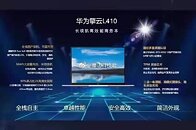- Joined
- Aug 19, 2017
- Messages
- 3,081 (1.09/day)
China's technology reliance on 3rd party companies seems to be getting smaller. One of the leading technology companies in China, Huawei, has designed a laptop powered by a custom 5 nm Kirin SoC with DDR5 memory. Called the Dyna Cloud L420, Huawei has prepared this model for the Chinese market to provide a fully functional laptop that will get the job done, with no risk of the potential security backdoors implemented in the processor. Powered by a brand new Kirin 9006C SoC manufactured on TSMC's 5 nm process, it features eight unknown cores running at 3.1 GHz frequency. We assume that those are custom cores designed by Huawei. This SoC is accompanied by 8 GB of LPDDR5 memory, with 256 GB and 512 GB UFS 3.1 configurations storage options.
When it comes to the rest of the laptop, it rocks a 14-inch 2160x1440 display. I/O options are solid as well, as this machine has an HDMI video output, two USB-A, one USB-C, and Gigabit Ethernet using a mini-RJ45 port. Connectivity is provided by Wi-Fi 6 and Bluetooth 4.2. There is a 56 W/h battery that provides the juice to keep it running when it comes to the battery. And to complete all of that, this laptop officially only supports Huawei's proprietary Kirin OS (KOS) and Unity OS (UOS), with expected support for HarmonyOS in the future. Pricing and availability information is a mistery at the present date.


View at TechPowerUp Main Site
When it comes to the rest of the laptop, it rocks a 14-inch 2160x1440 display. I/O options are solid as well, as this machine has an HDMI video output, two USB-A, one USB-C, and Gigabit Ethernet using a mini-RJ45 port. Connectivity is provided by Wi-Fi 6 and Bluetooth 4.2. There is a 56 W/h battery that provides the juice to keep it running when it comes to the battery. And to complete all of that, this laptop officially only supports Huawei's proprietary Kirin OS (KOS) and Unity OS (UOS), with expected support for HarmonyOS in the future. Pricing and availability information is a mistery at the present date.



View at TechPowerUp Main Site





